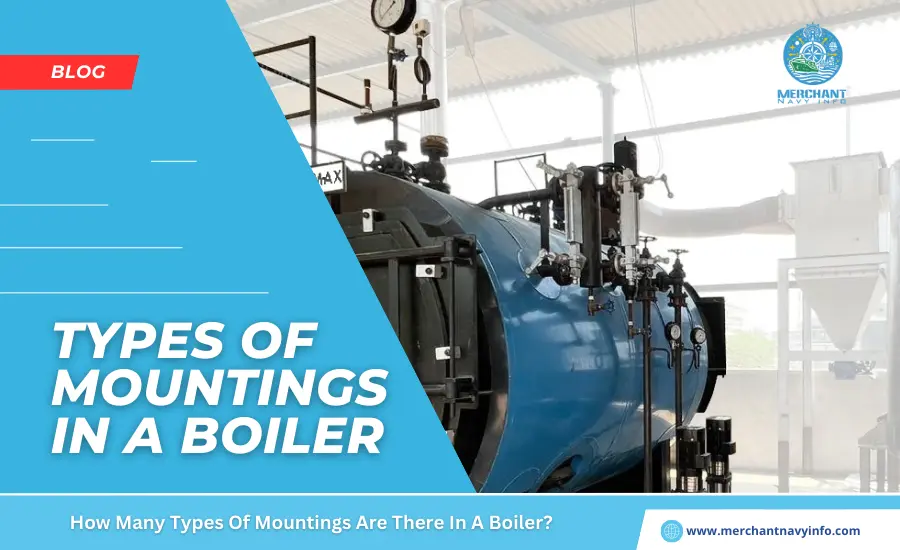
Boilers are one of the oldest mechanical systems in a ship’s engine room. In the early days, ships’ propulsion systems were powered by steam produced in boilers. With advances in technology and the increasing importance of ship and also crew safety. A variety of boiler mountings and boiler safety devices have been introduced.
Merely installing a boiler on a ship does not guarantee efficient operation of the boiler. Boiler mountings installation on board is only considered complete. When various types of boiler accessories have been installed. Including boiler control equipment, to ensure the safe and also efficient operation of the gas boiler. This article contains a comprehensive list of boiler fittings that prevent marine boilers from functioning safely and also efficiently.
Main Steam Isolation Valve
The steam generated in the boiler is supplied to the onboard system via this valve. This is usually a check valve installed directly in the steam space of the boiler shell. The housing is made of cast iron and also the valve seat is made of gunmetal.
Auxiliary Steam Shutoff Valve
In most steam systems on ships. This valve feeds a separate steam line from the boiler to a small auxiliary system. Valves are smaller and usually check valves.
Boiler Safety Valve
This is one of the most important boiler mountings used in case of unsafe overpressure in the boiler. Boiler safety valves are designed to operate to relieve excess pressure. The valve lift pressure is set before installation, ensured in the presence of an expert, and cannot be changed afterward. The boiler safety valves are installed in pairs, with one valve set at a slightly higher pressure. To ensure that the boiler mountings does not explode due to overpressure. In the event of a boiler safety valve failure.
Boiler Mirror Sight Glasses
Boiler Mirror Sight Glasses are installed in pairs and are used for manual control of the water level in the boiler. The structure of the sight glass is determined based on the boiler pressure. A boiler water level gauge is an important boiler accessory. That indicates the status of the water level in the boiler’s steam drum.
Vent Valve or Boiler Vent
This valve is installed in headers, also boiler drums, etc. To prevent explosions during depressurization of the boiler or during initial pressure rise of steam. The term implosion is the exact opposite of explosion. In this scenario, the pressure inside the boiler drops significantly below atmospheric pressure, causing the shell to bulge inward.
Supply Control
This valve controls the steam supply as required and is also installed in both. The main steam line and the auxiliary steam line after the isolation valve. This is a check valve that visually displays the open and closed positions.
Pressure Gauge Connection
Pressure gauges can be installed wherever real-time pressure values need to be read from superheaters, boiler bodies, and also local stations.
Boiler Drain Valve
The bottom drain valve is used to completely drain the boiler for maintenance purposes or partially for boiler water treatment in case of high chlorine content in the boiler water.
Foam Blow-Off Valve
This is a flat cup assembly that is placed at normal water level, which allows this. Typically, a sample water tap is also placed in series with the cooler so that a water sample can be taken at any time for feedwater analysis.
Whistle Valve
If the ship is equipped with a steam whistle, steam is supplied directly from the boiler through a small diameter check valve called a whistle valve.
Low Water Level Alarm
A device that emits an alarm when the water level is low. Below this level, another shutdown alarm (burner shutdown) is installed to prevent boiler mountings overheating (low-low level alarm).
Soot Blower
Required to blow soot and combustion products from pipe surfaces. Actuation takes place with steam or compressed air.
Automatic Water Regulator
This device is essential to ensure proper water level under all load conditions and is installed in the water supply line. Boilers with high evaporation rates use multi-element feedwater control systems.
Manholes
Boilers are equipped with multiple manhole doors to allow personnel access to the interior for inspection, cleaning, and maintenance of boiler pipes and internal components. There is usually one door for the steam drum and one for the water drum.
Sludge Box
The mud box inside the boiler is located at the bottom of the drum and collects the sludge (muddy impurities) in the drum.
TDS Sensor and Probe
Most modern boilers are now equipped with this device for continuous monitoring of the total amount of dissolved solids in the boiler water. The sensor compares the true value with the set value, and also if the value is high, an audio and visual alarm is issued. A manual blowdown can be performed to introduce fresh water to the system and also reduce total dissolved solids levels.










